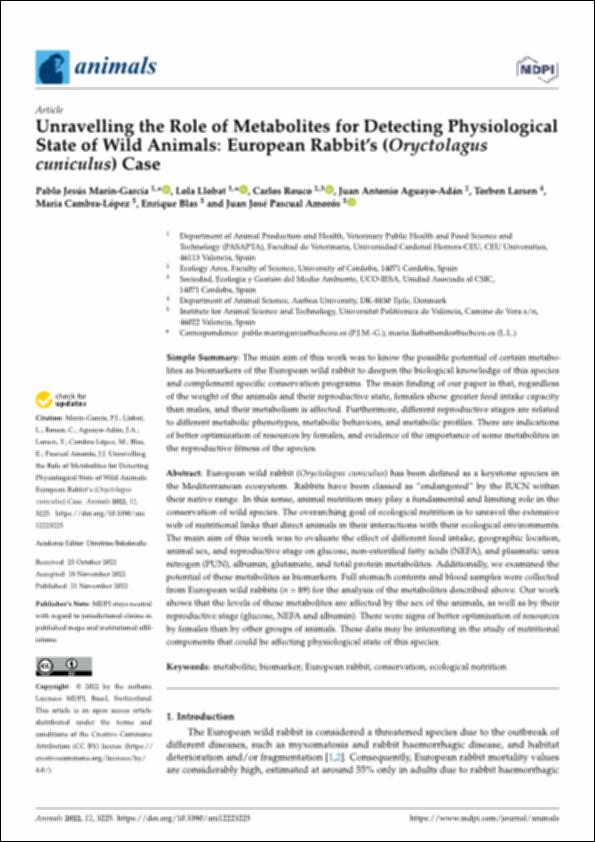Por favor, use este identificador para citar o enlazar este ítem:
http://hdl.handle.net/10637/14188Unravelling the role of metabolites for detecting physiological state of wild animals European rabbit's (Oryctolagus cuniculus) case
| Título : | Unravelling the role of metabolites for detecting physiological state of wild animals European rabbit's (Oryctolagus cuniculus) case |
| Autor : | Marín García, Pablo Jesús Llobat Bordes, Lola Rouco Zufiaurre, Carlos Aguayo Adán, Juan Antonio Larsen, Torben Cambra López, María Blas Ferrer, Enrique Pascual Amorós, Juan José |
| Materias: | Conejos - Alimentación - Aspectos bioquímicos.; Rabbits - Protection.; Conejos - Protección.; Rabbits - Feeding and feeds - Biochemical aspects. |
| Editorial : | MDPI |
| Citación : | Marín-García, P. J., Llobat, L., Rouco, C., Aguayo-Adán, J. A., Larsen, T., Cambra-López, M., Blas, E. et al. (2022). Unravelling the role of metabolites for detecting physiological state of wild animals: european rabbit’s (Oryctolagus cuniculus) case. Animals, vol. 12, i. 22 (21 nov.), art. 3225. DOI: http://dx.doi.org/10.3390/ani12223225 |
| Resumen : | European wild rabbit (Oryctolagus cuniculus) has been defined as a keystone species in the Mediterranean ecosystem. Rabbits have been classed as “endangered” by the IUCN within their native range. In this sense, animal nutrition may play a fundamental and limiting role in the conservation of wild species. The overarching goal of ecological nutrition is to unravel the extensive web of nutritional links that direct animals in their interactions with their ecological environments. The main aim of this work was to evaluate the effect of different feed intake, geographic location, animal sex, and reproductive stage on glucose, non-esterified fatty acids (NEFA), and plasmatic urea nitrogen (PUN), albumin, glutamate, and total protein metabolites. Additionally, we examined the potential of these metabolites as biomarkers. Full stomach contents and blood samples were collected from European wild rabbits (n = 89) for the analysis of the metabolites described above. Our work shows that the levels of these metabolites are affected by the sex of the animals, as well as by their reproductive stage (glucose, NEFA and albumin). There were signs of better optimisation of resources by females than by other groups of animals. These data may be interesting in the study of nutritional components that could be affecting physiological state of this species. |
| Descripción : | Este artículo se encuentra disponible en la siguiente URL: https://www.mdpi.com/2076-2615/12/22/3225 Este artículo pertenece a la colección "Recent Advance in Wildlife Conservation". |
| URI : | http://hdl.handle.net/10637/14188 |
| Derechos: | http://creativecommons.org/licenses/by/4.0/deed.es |
| ISSN : | 2076-2615 (Electrónico) |
| Idioma: | es |
| Fecha de publicación : | 21-nov-2022 |
| Centro : | Universidad Cardenal Herrera-CEU |
| Aparece en las colecciones: | Dpto. Producción y Sanidad Animal, Salud Pública Veterinaria y Ciencia y Tecnología de los Alimentos |
Los ítems de DSpace están protegidos por copyright, con todos los derechos reservados, a menos que se indique lo contrario.


